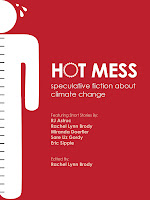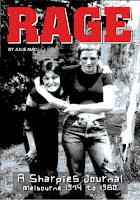by Julie Mac
published Melbourne 2010
Most young people haven't heard of Sharpies. In fact, even when presented with the facts, their existence seems pretty far-fetched. Violent gangs who wore cardigans and platform shoes and roamed the outer suburbs looking for fights? Sounds like the premise for an unlikely Australian remake of "The Warriors".
Sharpies were real however and any doubters should read "Rage" by Julie Mac. It's the actual journal of a Melbourne Sharpie, and it traces the six years between 1974 and 1980. Julie is a precocious teenager, at the age of thirteen she is comfortable with fighting, drinking, sex, and looks old enough to buy alcohol legally if she needs to (I for one can't imagine starting so early but it certainly makes a colourful story). Her early entries are about Sharpies that she sees near her school. She initially seems to dislike them, but soon comes to release that she is one. She starts dating an older Sharpie boy called Skeeta and becomes part of his gang - the Box Hill Sharps. Later she starts dating Igby and joins the West Side Sharps. Finally she starts dating Chap and rolling with the Melbourne Sharps. (The membership of Sharpie factions doesn't seem to be very well defined so I might have got it a bit mixed up).
Reading this is a bit like attending an Anthropology class about Sharpies. I found it interesting that most of the action happens in the suburbs. Unlike some other subcultures, for example goth, or punk, the Sharps were very spread out. They routinely travelled long distances, by train, car, or even hitch-hiking, slept over at friends' houses and partied when their parents were away. Their enemies were typically Seaweeds (surfers), Rockers and Bikies, other Sharpie gangs, and occasionally ethnic gangs. The girls were also pretty violent, and it was apparently normal for girls to beat each other up and even attack boys on occasion. The Sharps were also not adverse to some serious vandalism, such as slashing and destroying every seat in a train carriage. Favourite pranks included hoax calls to the fire brigade and bomb threats. Tattoos, haircuts, and clothes shopping were important, and Julie often notes down the brands of each item she wears.
This book gets better as it goes along - the section featuring Igby is particularly good. Here there are rolling battles in Alexandra gardens, wild parties and a real sense of vitality. Other parts of the book feel a little bit prozaic. Occasionally Julie mentions other (more exotic) subcultures which seem to coexist with the Sharpies - such as Bowies, who presumably dress something like David Bowie. The Sharps seem to usually get along with Bowies and Skinheads (or Skins), in fact it's a bit difficult to tell what makes people belong to a certain group. Interestingly punks don't exist yet in Melbourne, although she notes the passing of Sid Vicious near the end of the diary and seems to be about to evolve into a punk when the diary suddenly ends. She is only sixteen. The book also features a few photos (in poor resolution), a couple of commentaries from notable Sharpie musicians (such as Angry Anderson), and a "where are they now" section.
I liked this a lot but unfortunately it was a bit long and I occasionally had to read it aloud in a silly voice to make it more interesting. There is some great material here for a retro gang film if anyone ever wanted to make one. The resemblance to films like "The Warriors", and "A Clockwork Orange" is quite palpable, and I found it interesting that she goes to see both films during the book. There's also a lot of current affairs which I liked, for example, the Granvillle train disaster. Sometimes though the voice seems to lack authenticity - is this really a thirteen year old girl? Some parts feel like they have been inserted artificially. There's also a lot of second-hand stories here, stories the narrator has apparently heard from someone else that she is relating with an unusual amount of detail.
I give this four out of five!! ****





.jpg)








